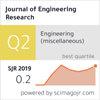时效热处理对AA6063管旋转拉伸弯曲成形性能和组织的影响
IF 0.9
4区 工程技术
Q3 ENGINEERING, MULTIDISCIPLINARY
引用次数: 0
摘要
研究了时效热处理对6063铝管旋转拉伸弯曲成形性能和微观组织特性的影响。为了确定能够在弯曲过程中产生理想硬度和成形性的热处理方案,管子在不同条件下进行了T3, T6和退火热处理循环,随后评估了管子的可弯曲性。结果表明,随着温度和溶解时间的升高,椭圆变形的程度相应增大,硬度值也相应增大。研究结果表明,温度和溶解时间的升高会导致弯曲试样的椭圆形状更加明显。例如,当样品在530°C和545°C下热处理60分钟时,与仅处理30分钟的样品相比,样品的椭圆度分别增加了5.30%和4.34%。此外,较高的内压导致椭圆变形程度降低,特别是在20 bar压力下观察到的降低了9.85%。随着热处理温度的升高和热处理时间的延长,试样的硬度呈上升趋势。为了详细说明,硬度测量在三种不同的温度(530°C, 545°C和560°C)和四种不同的持续时间(30,45,60和75分钟)下进行。在560℃下经过75分钟热处理的样品显示出最高的硬度值,测量值为62.55 HV。综上所述,时效热处理可以提高6063铝管RDB成形性能。此外,温度和内压是控制椭圆变形和提高硬度的关键参数。本文章由计算机程序翻译,如有差异,请以英文原文为准。
The effect of aging heat treatment on the formability and microstructure of the AA6063 tube in the rotary draw bending process
This research delves into the impact of aging heat treatment on both the formability and microstructural characteristics of 6063 aluminum tubes when subjected to the rotary draw bending (RDB) procedure. To ascertain a heat treatment regimen that can yield desirable hardness and formability for the bending process, the tube was subjected to T3, T6, and annealing heat treatment cycles under diverse conditions and subsequently the tube's bendability was evaluated. The findings indicate that as temperature and dissolution time are raised, there is a corresponding rise in the extent of elliptical deformation, consequently resulting in higher hardness values. The research outcomes suggest that elevating both temperature and dissolution time leads to a more pronounced elliptical shape in the bent sample. For instance, when subjected to heat treatment at 530 °C and 545 °C for 60 min, the samples exhibited respective increases in ellipticity of 5.30 % and 4.34 % compared to those treated for just 30 min. Additionally, higher internal pressure led to a reduction in the degree of elliptical deformation, notably a decrease of 9.85 % observed at a pressure of 20 bar. Moreover, the hardness of samples subjected to the T3 cycle exhibited an upward trend with increasing both temperature and duration of heat treatment. To elaborate, the hardness measurements were conducted at three distinct temperatures (530 °C, 545 °C, and 560 °C) and four different durations (30, 45, 60, and 75 min). The sample subjected to a 75-minute heat treatment at 560 °C exhibited the highest recorded hardness value, measuring at 62.55 HV. In summary, the results indicate that aging heat treatment can enhance the formability of 6063 aluminum tubes during the RDB process. Furthermore, it is noteworthy that temperature and internal pressure serve as crucial parameters to control in order to mitigate elliptical deformation and enhance hardness.
求助全文
通过发布文献求助,成功后即可免费获取论文全文。
去求助
来源期刊

Journal of Engineering Research
ENGINEERING, MULTIDISCIPLINARY-
CiteScore
1.60
自引率
10.00%
发文量
181
审稿时长
20 weeks
期刊介绍:
Journal of Engineering Research (JER) is a international, peer reviewed journal which publishes full length original research papers, reviews, case studies related to all areas of Engineering such as: Civil, Mechanical, Industrial, Electrical, Computer, Chemical, Petroleum, Aerospace, Architectural, Biomedical, Coastal, Environmental, Marine & Ocean, Metallurgical & Materials, software, Surveying, Systems and Manufacturing Engineering. In particular, JER focuses on innovative approaches and methods that contribute to solving the environmental and manufacturing problems, which exist primarily in the Arabian Gulf region and the Middle East countries. Kuwait University used to publish the Journal "Kuwait Journal of Science and Engineering" (ISSN: 1024-8684), which included Science and Engineering articles since 1974. In 2011 the decision was taken to split KJSE into two independent Journals - "Journal of Engineering Research "(JER) and "Kuwait Journal of Science" (KJS).
 求助内容:
求助内容: 应助结果提醒方式:
应助结果提醒方式:


